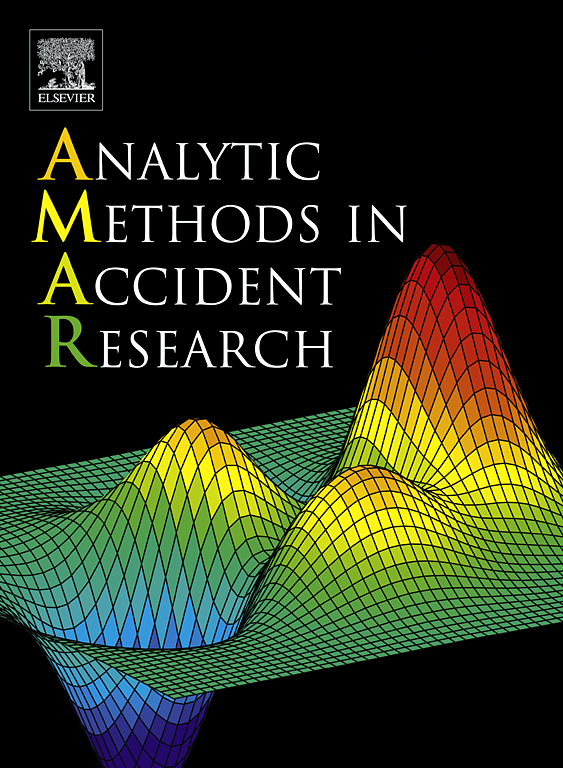Autonomous vehicle lane-changing dynamics and impact on the immediate follower
IF 12.6
1区 工程技术
Q1 PUBLIC, ENVIRONMENTAL & OCCUPATIONAL HEALTH
引用次数: 0
Abstract
Understanding and modelling lane-changing behaviour are critical aspects of microscopic traffic flow modelling, safety analyses, and microsimulation due to their significant impact on traffic flow characteristics and safety. Among the three aspects of lane-changing behaviour—decision-making, execution, and impact—the lane-changing impact has been comparatively underexplored in the literature, which is disproportionate to its importance. A lack of proper understanding of lane-changing impact may lead to inaccurate planning and interpretation of mixed traffic stream comprising both autonomous and human-driven vehicles. Motivated by this research gap, the current study investigates the lane-changing impact of autonomous vehicles on the immediate follower using the publicly available Waymo Open Dataset. Human-driven vehicle lane-changing data are also extracted from the same database and used for comparison. Lane-changing impact on traffic flow efficiency and safety is examined through the speed reduction of the follower in the target lane and deceleration rate to avoid a collision for the same follower, respectively. A correlated random parameters linear regression model is employed to assess the speed reduction of the follower as a function of lane-change duration, lag gap, lane-changer speed, and a dummy variable indicating whether the lane-changer is an autonomous vehicle or a human-driven vehicle. The results reveal that lane changes executed by autonomous vehicles may cause greater or lesser speed reductions for the follower compared to those executed by human-driven vehicles, which could be attributed to the heterogeneous behaviour of followers perceiving and responding differently to autonomous vehicle lane-changes compared to human-driven ones. Further, the block maxima and peak over threshold models are developed to estimate crash risk for the follower in the target lane using a deceleration rate to avoid a collision conflict measure. The results suggest that the risk of a collision increases substantially when the lane-changer is an autonomous vehicle. This elevated risk may be associated with drivers’ lack of trust in autonomous vehicles and traffic dynamics, reflecting self-inflicting hard deceleration to avoid potential collisions. Overall, this study highlights the heterogeneous impacts of lane-changing by autonomous vehicles on the immediate follower, emphasising the need for tailored models that accurately capture the dynamics of surrounding traffic behaviour. The findings will be helpful to road safety engineers and policymakers in planning mixed traffic with the safe integration of autonomous vehicles.
自动驾驶汽车变道动力学及其对直接跟随者的影响
理解和模拟变道行为是微观交通流建模、安全分析和微观模拟的关键方面,因为它们对交通流特征和安全有重大影响。在变道行为的三个方面——决策、执行和影响中,文献中对变道影响的研究相对较少,与其重要性不成比例。缺乏对变道影响的正确理解可能会导致对混合交通流的不准确规划和解释,包括自动驾驶和人类驾驶的车辆。受这一研究差距的启发,目前的研究使用公开的Waymo开放数据集调查了自动驾驶汽车对直接跟随者的变道影响。人类驾驶车辆变道数据也从同一数据库中提取,并用于比较。分别通过目标车道内从动车减速和同一从动车为避免碰撞而减速度来考察变道对交通流效率和安全的影响。采用相关随机参数线性回归模型,以变道时间、滞后间隙、变道速度和指示变道车辆是自动驾驶车辆还是人为驾驶车辆的虚拟变量为函数来评估跟随者的速度降低。结果显示,与人类驾驶的车辆相比,自动驾驶车辆执行的变道可能会导致跟随者的速度降低或多或少,这可能归因于与人类驾驶的车辆相比,跟随者对自动驾驶车辆变道的感知和反应不同。在此基础上,建立了块最大值和峰值超过阈值模型,利用减速度来估计目标车道上跟随者的碰撞风险,以避免碰撞冲突措施。研究结果表明,当变道者是自动驾驶汽车时,发生碰撞的风险会大幅增加。这种增加的风险可能与驾驶员对自动驾驶汽车和交通动态缺乏信任有关,这反映了他们为了避免潜在的碰撞而自我施加硬减速。总的来说,这项研究强调了自动驾驶汽车变道对直接跟随者的异质影响,强调了精确捕捉周围交通行为动态的定制模型的必要性。研究结果将有助于道路安全工程师和政策制定者规划混合交通与自动驾驶汽车的安全集成。
本文章由计算机程序翻译,如有差异,请以英文原文为准。
求助全文
约1分钟内获得全文
求助全文
来源期刊

Analytic Methods in Accident Research
Multiple-
CiteScore
22.10
自引率
34.10%
发文量
35
审稿时长
24 days
期刊介绍:
Analytic Methods in Accident Research is a journal that publishes articles related to the development and application of advanced statistical and econometric methods in studying vehicle crashes and other accidents. The journal aims to demonstrate how these innovative approaches can provide new insights into the factors influencing the occurrence and severity of accidents, thereby offering guidance for implementing appropriate preventive measures. While the journal primarily focuses on the analytic approach, it also accepts articles covering various aspects of transportation safety (such as road, pedestrian, air, rail, and water safety), construction safety, and other areas where human behavior, machine failures, or system failures lead to property damage or bodily harm.
 求助内容:
求助内容: 应助结果提醒方式:
应助结果提醒方式:


